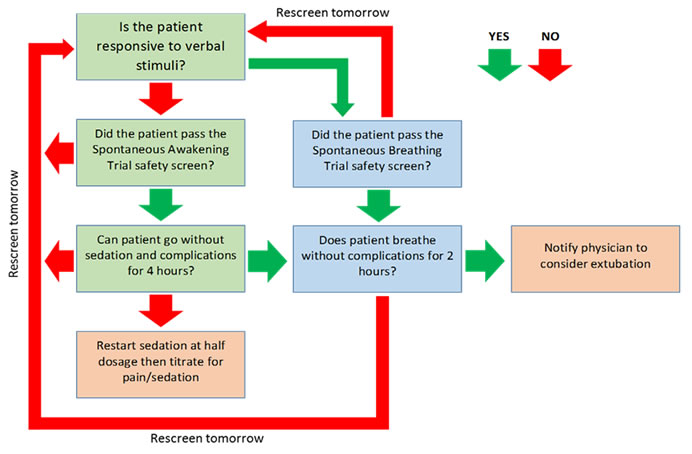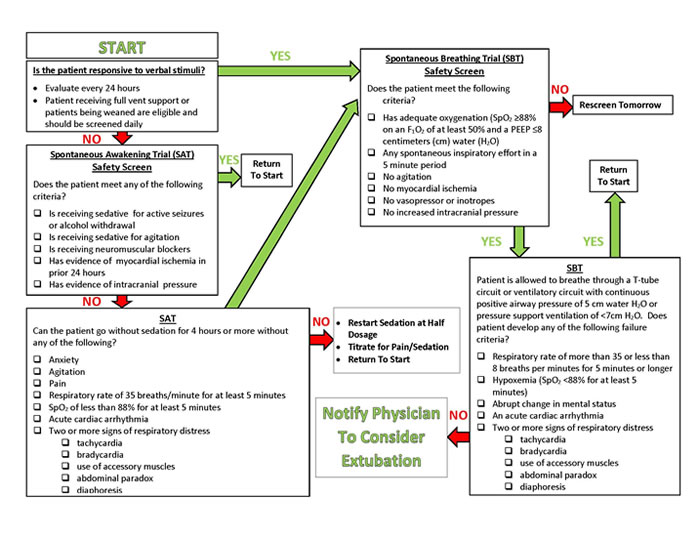AHRQ Safety Program for Mechanically Ventilated Patients
Introduction
Reducing the number of days a patient is on mechanical ventilation has been shown to reduce the risk of ventilator-associated pneumonia.1,2,3 Strategies for weaning patients off of mechanical ventilation are often not handled well, as the spontaneous awakening trials (SAT) and spontaneous breathing trials (SBT) are viewed separately. A protocol using coordinated SAT and SBT can significantly reduce the number of days patients are on mechanical ventilation. Girard et al. showed that when paired, the SAT and SBT reduced the number of days patients were on mechanical ventilation (3.1-day reduction, 95% confidence interval 0.7–5.6; p=0.02), with a concomitant reduction in the length of hospital stay (4.0 days difference) when compared with SBT alone.4 This same technique, often called a readiness-to-wean, "wake up and breathe," or coordinated sedation and weaning protocol, has been used in other institutions with much success.3,5,6,7 We are using the model Girard et al. developed in 2008 for this project.4
Spontaneous Awakening Trial
The SAT consists of two parts, a safety screen and the trial (Figures 1 and 2). The safety screen checks for contraindications. A patient passes the screen unless the following factors are present:
- Receiving a sedative infusion for active seizures or alcohol withdrawal.
- Receiving escalating doses of sedative for agitation.
- Receiving neuromuscular blockers.
- Evidence of active myocardial ischemia in prior 24 hours.
- Evidence of increased intracranial pressure.
If the patient passes the safety screen, all sedatives and analgesics used for sedation are stopped. Analgesics used for pain are continued as necessary. The goal is that the patient can do three out of four simple tasks on request: open their eyes, look at their caregiver, squeeze the hand, or put out their tongue3 or can go without sedation for 4 hours or more without the following:
- Sustained anxiety, agitation, or pain.
- Respiratory rate of 35 breaths/minute for at least 5 minutes.
- Oxygen saturation (SpO2) of less than 88% for at least 5 minutes.
- Acute cardiac dysrhythmia.
- Two or more signs of respiratory distress:
- Tachycardia.
- Bradycardia.
- Use of accessory muscles.
- Abdominal paradox.
- Diaphoresis.
- Marked dyspnea.
If a patient fails the SAT, sedatives are started at half the prior dosage and titrated up as needed.
Spontaneous Breathing Trial
If a patient passes the SAT, the patient is assessed for the SBT safety screen. A patient fails the safety screen if any of the following conditions are met:
- Inadequate oxygenation (SpO2 < 88% or an FiO2 of ≥ 50% and a positive end-expiratory pressure [PEEP] ≥ 8 cm H2O).
- No spontaneous inspiratory effort in a 5-minute period (Consideration of the set respiratory rate is recommended).
- Agitation.
- Significant use of vasopressors or inotropes (patients may be on dopamine or dobutamine at ≤5 µg/kg/min or norepinephrine ≤2 µg/min, but may not be receiving any vasopressin or milrinone).8
- Evidence of increased intracranial pressure.
If a patient fails the safety screen, sedatives are started at half the prior dosage and titrated up as necessary. The patient is then reassessed for SAT the following day. If the patient passes the safety screen, he or she undergoes the SBT. Ventilatory support is removed. The patient is allowed to breathe through either a T-tube circuit of a ventilatory circuit with continuous positive airway pressure of 5 cm H2O or pressure support ventilation of less than 7 cm H2O. A patient passes the trial if he or she avoids developing any of the following failure criteria within 120 minutes:
- Respiratory rate of either fewer than 8 breaths per minute (bpm) or more than 35 bpm for 5 minutes or longer.
- Hypoxemia (SpO2 < 88% for ≥ 5 minutes).
- Abrupt change in mental status.
- Acute cardiac arrhythmia.
- Two or more signs of respiratory distress:
- Tachycardia.
- Bradycardia.
- Use of accessory muscles.
- Abdominal paradox.
- Diaphoresis.
- Marked dyspnea.
If a patient fails the SBT, he or she is reassessed for SAT and SBT the following day. If a patient passes the SBT, the patient’s physicians are notified for possible extubation.
Figure 1. Coordinated SAT and SBT Protocol Summary

Figure 2. Coordinated SAT and SBT Protocol Flowchart

References
- Ely EW, Baker AM, Dunagan DP, et al. Effect on the duration of mechanical ventilation of identifying patients capable of breathing spontaneously. N Engl J Med 1996 Dec;335(25):1864-9. PMID: 8948561.
- Brook AD, Ahrens TS, Schaiff R, et al. Effect of a nursing-implemented sedation protocol on the duration of mechanical ventilation. Crit Care Med 1999 Dec;27(12):2609-15. PMID: 10628598.
- Kress JP, Pohlman AS, O'Connor MF, et al. Daily interruption of sedative infusions in critically ill patients undergoing mechanical ventilation. N Engl J Med 2000 May;342(20):1471-7. PMID: 10816184.
- Girard TD, Kress JP, Fuchs BD, et al. Efficacy and safety of a paired sedation and ventilator weaning protocol for mechanically ventilated patients in intensive care (awakening and breathing controlled trial): A randomised controlled trial. Lancet 2008 Jan;371(9607):126-34. PMID: 18191684.
- Blackwood B, Alderdice F, Burns K, et al. Use of weaning protocols for reducing duration of mechanical ventilation in critically ill adult patients: Cochrane systematic review and meta-analysis. BMJ 2011 Jan;342:c7237. PMID: 21233157.
- Quenot JP, Ladoire S, Devoucoux F, et al. Effect of a nurse-implemented sedation protocol on the incidence of ventilator-associated pneumonia. Crit Care Med 2007 Sep;35(9):2031-6. PMID: 17855817.
- Klompas M, Anderson D, Trick, W, et al. The Preventability of ventilator-associated events. The CDC Prevention Epicenters Wake Up and Breathe Collaborative. Am J Respir Crit Care Med 2015 Feb;191(3):292-301. PMID: 25369558.
- Thompson J, Ely E. Liberating patients from mechanical ventilation: what have we learned about protocolizing care? In: Slutsky A, Brochard L, eds. Mechanical Ventilation. Berlin, Germany: Springer-Verlag Berlin Heidelberg; 2004:135-51.



